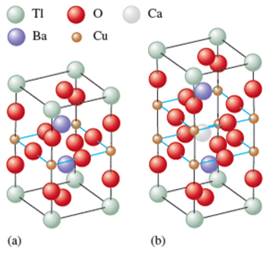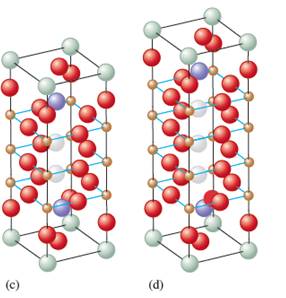
(a)
Interpretation: The formula of the four superconductors needs to be determined.
Concept Introduction: The superconductor is a substance which is capable of superconducting at very low temperature values.
(a)
Explanation of Solution
The given structures are as follows:


By considering the color code for spheres, the number of atoms of each element can be counted.
It can be observed that in molecule (a) there is 1 Tl, 2 Ba, 1 Cu and 5 O atoms in 1unit. Thus, the formula of the molecule will be:
Similarly, the atoms in molecule (b) are 1 Tl, 2 Ba, 1 Ca, 1 Cu and 7 O in 1unit. Thus, the formula will be:
The structure (c) contains 1 Tl, 2 Ba, 2 Ca, 3 Cu and 9 O atoms in 1unit. The formula will be:
Similarly, the structure (d) has 1 Tl, 2 Ba, 2 Ca, 4 Cu and 11 O atoms in 1unit thus, the molecular formula will be:
(b)
Interpretation: The four structures needs to be ordered from lowest to highest superconducting temperature.
Concept introduction: The number of sheets in the unit cell is directly proportional to the temperature for the superconductivity.
(b)
Explanation of Solution
If the number of sheets in each unit cell increases, the temperature for the superconductivity increases. The number of sheets in the structure (a) is less then (b) which is further less than (c) and (d). Thus, the increasing order of the superconductivity for 4 structures will be as follows:
(c)
Interpretation: The oxidation state needs to be assigned to Cu in each mixture. It is assumed that the oxidation state of Tl is +3. Also, the oxidation state of Ca, Ba, O is +2, +2 and -2 respectively.
Concept Introduction: The oxidation state of any atom in the molecule is equal to the charge on it. It can be calculated if oxidation state of all the other atoms is given.
For example, the molecule H2O2 is neutral. The oxidation state of H is +1 (general) thus, the oxidation state of O can be calculated as follows:
Thus, the oxidation state of O in H2O2 is -1.
(c)
Explanation of Solution
The oxidation state of Cu in structure can be calculated by taking the overall charge on the molecule equal to zero.
The oxidation state of Tl, Ca, Ba and O is assumed +3, +2, +2 and -2 respectively.
For
Thus, the oxidation state of Cu in molecule (a) is +3.
For
There are 2 Cu atoms, thus, there is a mixed oxidation state one is
For
Thus, copper has mixed oxidation state that is 1
For
There will be one
(d)
Interpretation: The reason for the copper to display a mixture of oxidation states in the superconductor needs to be explained.
Concept Introduction: The superconductor is a substance which is capable of superconducting at very low temperature values.
(d)
Explanation of Solution
There are variable oxidation states of copper due to varying the numbers of Ca, Cu and O atoms in each unit cell. The different oxidation states of Cu are calculated for molecules (b), (c) and (d). In the other superconductor in exercise 79, in YBa2Cu3O7, there is variable oxidation state of copper by omitting oxygen atom at various sites in the lattice.
Want to see more full solutions like this?
Chapter 16 Solutions
Chemical Principles
- What are the angles a and b in the actual molecule of which this is a Lewis structure? H- :0: C=N: b Note for advanced students: give the ideal angles, and don't worry about small differences from the ideal that might be caused by the fact that different electron groups may have slightly different sizes. a = 0° b=0 Xarrow_forwardA student proposes the transformation below in one step of an organic synthesis. There may be one or more products missing from the right-hand side, but there are no reagents missing from the left-hand side. There may also be catalysts, small inorganic reagents, and other important reaction conditions missing from the arrow. • Is the student's transformation possible? If not, check the box under the drawing area. • If the student's transformation is possible, then complete the reaction by adding any missing products to the right-hand side, and adding required catalysts, inorganic reagents, or other important reaction conditions above and below the arrow. • You do not need to balance the reaction, but be sure every important organic reactant or product is shown. + This transformation can't be done in one step. T iarrow_forwardDetermine the structures of the missing organic molecules in the following reaction: H+ O OH H+ + H₂O ☑ ☑ Note: Molecules that share the same letter have the exact same structure. In the drawing area below, draw the skeletal ("line") structure of the missing organic molecule X. Molecule X shows up in multiple steps, but you only have to draw its structure once. Click and drag to start drawing a structure. X § ©arrow_forward
- Table 1.1 Stock Standard Solutions Preparation. The amounts shown should be dissolved in 100 mL. Millipore water. Calculate the corresponding anion concentrations based on the actual weights of the reagents. Anion Amount of reagent (g) Anion Concentration (mg/L) 0.1649 Reagent Chloride NaCl Fluoride NaF 0.2210 Bromide NaBr 0.1288 Nitrate NaNO3 0.1371 Nitrite NaNO2 0.1500 Phosphate KH2PO4 0.1433 Sulfate K2SO4 0.1814arrow_forwardDraw the structure of the pound in the provided CO as a 300-1200 37(2), 11 ( 110, and 2.5 (20arrow_forwardPlease help me with # 4 and 5. Thanks in advance!arrow_forward
- A small artisanal cheesemaker is testing the acidity of their milk before it coagulates. During fermentation, bacteria produce lactic acid (K₁ = 1.4 x 104), a weak acid that helps to curdle the milk and develop flavor. The cheesemaker has measured that the developing mixture contains lactic acid at an initial concentration of 0.025 M. Your task is to calculate the pH of this mixture and determine whether it meets the required acidity for proper cheese development. To achieve the best flavor, texture and reduce/control microbial growth, the pH range needs to be between pH 4.6 and 5.0. Assumptions: Lactic acid is a monoprotic acid H H :0:0: H-C-C H :0: O-H Figure 1: Lewis Structure for Lactic Acid For simplicity, you can use the generic formula HA to represent the acid You can assume lactic acid dissociation is in water as milk is mostly water. Temperature is 25°C 1. Write the K, expression for the dissociation of lactic acid in the space provided. Do not forget to include state symbols.…arrow_forwardCurved arrows are used to illustrate the flow of electrons. Using the provided starting and product structures, draw the curved electron-pushing arrows for the following reaction or mechanistic step(s). Be sure to account for all bond-breaking and bond-making steps. :0: :0 H. 0:0 :0: :6: S: :0: Select to Edit Arrows ::0 Select to Edit Arrows H :0: H :CI: Rotation Select to Edit Arrows H. < :0: :0: :0: S:arrow_forward3:48 PM Fri Apr 4 K Problem 4 of 10 Submit Curved arrows are used to illustrate the flow of electrons. Using the provided starting and product structures, draw the curved electron-pushing arrows for the following reaction or mechanistic step(s). Be sure to account for all bond-breaking and bond-making steps. Mg. :0: Select to Add Arrows :0: :Br: Mg :0: :0: Select to Add Arrows Mg. Br: :0: 0:0- Br -190 H 0:0 Select to Add Arrows Select to Add Arrows neutralizing workup H CH3arrow_forward
- Iarrow_forwardDraw the Markovnikov product of the hydrobromination of this alkene. Note for advanced students: draw only one product, and don't worry about showing any stereochemistry. Drawing dash and wedge bonds has been disabled for this problem. + Explanation Check 1 X E 4 1 1 1 1 1 HBr Click and drag to start drawing a structure. 80 LE #3 @ 2 $4 0 I அ2 % 85 F * K M ? BH 2025 McGraw Hill LLC. All Rights Reserved. Terms of Use Privacy Center & 6 27 FG F10 8 9 R T Y U D F G H P J K L Z X C V B N M Q W A S H option command H command optiarrow_forwardBe sure to use wedge and dash bonds to show the stereochemistry of the products when it's important, for example to distinguish between two different major products. Predict the major products of the following reaction. Explanation Q F1 A Check F2 @ 2 # 3 + X 80 F3 W E S D $ 4 I O H. H₂ 2 R Pt % 05 LL ee F6 F5 T <6 G Click and drag to start drawing a structure. 27 & A 2025 McGraw Hill LLC. All Rights Reserved. Terms of Use Privacy Center Acce Y U H DII 8 9 F10 4 J K L Z X C V B N M T H option command F11 P H commandarrow_forward
 Physical ChemistryChemistryISBN:9781133958437Author:Ball, David W. (david Warren), BAER, TomasPublisher:Wadsworth Cengage Learning,
Physical ChemistryChemistryISBN:9781133958437Author:Ball, David W. (david Warren), BAER, TomasPublisher:Wadsworth Cengage Learning, Chemistry by OpenStax (2015-05-04)ChemistryISBN:9781938168390Author:Klaus Theopold, Richard H Langley, Paul Flowers, William R. Robinson, Mark BlaserPublisher:OpenStax
Chemistry by OpenStax (2015-05-04)ChemistryISBN:9781938168390Author:Klaus Theopold, Richard H Langley, Paul Flowers, William R. Robinson, Mark BlaserPublisher:OpenStax ChemistryChemistryISBN:9781305957404Author:Steven S. Zumdahl, Susan A. Zumdahl, Donald J. DeCostePublisher:Cengage Learning
ChemistryChemistryISBN:9781305957404Author:Steven S. Zumdahl, Susan A. Zumdahl, Donald J. DeCostePublisher:Cengage Learning Chemistry: An Atoms First ApproachChemistryISBN:9781305079243Author:Steven S. Zumdahl, Susan A. ZumdahlPublisher:Cengage Learning
Chemistry: An Atoms First ApproachChemistryISBN:9781305079243Author:Steven S. Zumdahl, Susan A. ZumdahlPublisher:Cengage Learning
 Chemistry: The Molecular ScienceChemistryISBN:9781285199047Author:John W. Moore, Conrad L. StanitskiPublisher:Cengage Learning
Chemistry: The Molecular ScienceChemistryISBN:9781285199047Author:John W. Moore, Conrad L. StanitskiPublisher:Cengage Learning





